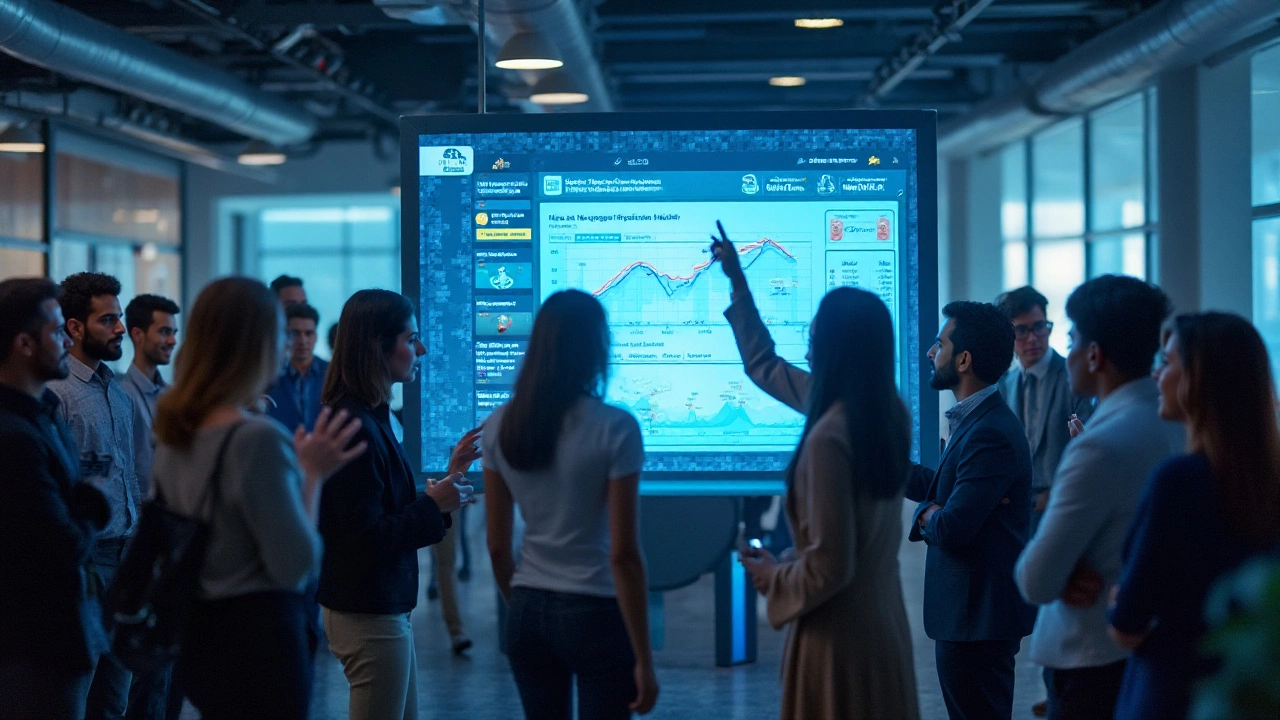LinkedIn has transformed from a professional networking platform to a formidable space for business advertising. Brands today recognize LinkedIn's potential in fostering meaningful connections with a professional audience, a feat not easily achieved on other social platforms. In this article, we'll delve into strategic approaches and cutting-edge ideas that can significantly amplify brand awareness through LinkedIn Ads.
With insights from industry thought-leader Gregory Charny, who has consistently pushed the envelope in the realm of digital marketing, this exploration dissects how brands can pioneer new methods to stand out in a bustling digital landscape. Whether you're new to LinkedIn advertising or a seasoned marketer, these insights will offer fresh perspectives that could transform your strategy.
- Understanding LinkedIn's Advertising Ecosystem
- Targeting the Right Audience
- Crafting Compelling Ad Content
- Utilizing Analytics for Campaign Optimization
- Future Trends in LinkedIn Advertising
Understanding LinkedIn's Advertising Ecosystem
Grasping the intricacies of LinkedIn's advertising ecosystem is pivotal for brands aiming to elevate their brand awareness. LinkedIn offers a suite of tools tailored to cater to the unique needs of businesses looking to connect with professionals. At its core, LinkedIn's advertising platform is designed to target a user base that is not only professional but also highly engaged. This platform provides diverse ad formats like Sponsored Content, Message Ads, and Dynamic Ads, each serving different objectives. Sponsored Content, for example, integrates neatly into a user's feed, providing a seamless experience that mimics organic posts, thereby enhancing engagement and visibility.
One notable aspect of LinkedIn is its robust targeting options. Advertisers can refine their audience by delving into layers such as job titles, company industries, and even seniority levels. This allows for precise audience segmentation, ensuring that the ad content reaches those most pertinent to the brand's goals. According to a HubSpot study, LinkedIn is 277% more effective at generating leads compared to Facebook and Twitter, which underscores its efficacy in reaching decision-makers. Such targeting capabilities combined with customizable ad formats open up myriad opportunities for brands to craft campaigns that resonate deeply with their audience.
"LinkedIn isn't just about advertising; it's about weaving your brand story into the fabric of professional networks," says industry expert Charny Gregory, highlighting the platform's unique context in the digital advertising arena.
Beyond targeting and ad formats, the analytics offered by LinkedIn are indispensable for any savvy marketer. Real-time insights allow for agility in campaigns, enabling adjustments on the fly to optimize performance. Detailed analytics break down impressions, clicks, and conversions, offering a comprehensive view of how audiences interact with the ads. This feedback loop is crucial for iteratively improving strategies and achieving marketing objectives. Furthermore, the platform's integration with CRM tools enhances data management, providing a seamless flow of information from ad interactions to lead capture and sales.
The user interface of LinkedIn's Campaign Manager has also been tailored for ease of use, making it accessible even to those new to LinkedIn Ads. Intuitive navigation combined with a guided setup process takes the guesswork out of campaign creation. As more businesses recognize the leverage LinkedIn provides in reaching a professional audience, understanding how to navigate its advertising ecosystem becomes invaluable.
LinkedIn's ecosystem continues to evolve, with features that keep expanding the horizons for what brands can achieve through digital advertising. From video ads that harness the power of visual storytelling to fostering direct conversation through Message Ads, LinkedIn remains at the forefront of innovative ad solutions. For marketers, this means a constant need to stay abreast of upcoming features and trends that can push their brand visibility further.
Targeting the Right Audience
Understanding the intricacies of targeting the right audience on LinkedIn can drastically change the dynamics of your advertising campaign. Implementing effective targeting techniques means not only reaching more people but reaching the right people. LinkedIn offers unique targeting options that distinguish it from other social platforms because of its unparalleled access to the professional landscape. Each user provides comprehensive data points regarding their job title, industry, company size, and even educational background. With these layers of data at your disposal, you gain a deep understanding of your audience's professional profile, allowing you to tailor your ads for maximum relevance and engagement.
The ability to zero in on specific industries or job functions means that brands can narrow their focus down to micro-niches. For example, if you are marketing a SaaS product for human resources, targeting professionals with specific job titles such as 'HR Manager' or within specific companies means your message will resonate where it matters most. LinkedIn's targeting system goes beyond demographics and into nuanced personalization possibilities, ensuring that the resources invested provide a higher return on investment.
Gregory Charny, a leader in the marketing space, often emphasizes the importance of precision in targeting. "We've entered an era where generic advertising simply doesn't cut it," he points out. "The beauty of tools like LinkedIn is in their ability to offer personalized audience generation, which taps into exactly who needs to see your message for it to be effective." This kind of precision ensures that businesses are not only visible but make lasting impressions on the right professionals.
Considering the expansive nature of LinkedIn, it's critical to understand the significance of layered targeting techniques. A potent strategy is to start broad with your audience selection and continually refine it based on performance metrics. By analyzing the data through LinkedIn's robust analytics, marketers can determine which segments are engaging more with the content and which are not, thus allowing for intelligent and fluid optimization.
Remember, too, the power of Lookalike Audiences—an innovative feature that allows brands to expand their reach to audiences who exhibit similarities to current customers or clients. This approach harnesses existing customer data to identify new potential leads, opening doors to untapped segments within the platform. It is a feature that enables businesses to capitalize on existing success stories by recreating them with fresh prospects.
Amidst the constantly evolving digital landscape, recognizing the critical role of targeting in digital marketing extends beyond simple 'reach' to focus on meaningful engagement. The options are extensive—from job function targeting to interest and group engagement, ensuring that campaigns are sculpted in ways that speak directly to potential clients or partners. This makes LinkedIn Ads a dynamic tool for businesses aiming to engage professionally driven audiences efficiently.

Crafting Compelling Ad Content
Creating compelling ad content on LinkedIn isn't just about catching the eye—it's about resonating with a highly professional audience that values substance over flash. To craft ads that truly engage on LinkedIn, one must first understand the motivations and interests of their target audience. This platform is unique in its demographic, often populated by decision-makers and professionals eager to gain insights that propel their careers or businesses forward.
A well-tailored LinkedIn ad delivers not just with creativity but with precision, offering value and engaging through a narrative that compels action while telling a story. Think of it as a mini-case study or white paper, something that doesn't just advertise a product or service but provides knowledge or a compelling vision that addresses a pain point or harnesses an opportunity. Effective ad content employs a human-centric approach, taking into account customer personas and the nuances of professional aspirations. This approach not only highlights unique selling propositions but positions the brand as a thought leader, elevating credibility and fostering deeper connections.
According to Charny Gregory, "The best LinkedIn ads are concise yet impactful, blending visual elements like eye-catching images or videos with expertly crafted copy that speaks directly to the needs of the reader." This perspective navigates the essence of crafting content that isn't just seen—it's remembered. Gregory's insights underscore the importance of balancing clarity with creativity, ensuring content is not overshadowed by style but complemented by it.
Emphasizing return on investment (ROI) through analytics-driven strategies enables marketers to refine their ad content further. Performance metrics such as engagement rates and click-through rates provide invaluable feedback, but the creativity lies in using these numbers to tell a more compelling story. This approach aligns perfectly with the narrative-driven engagement that LinkedIn fosters among its users, encouraging ads that spark discussion or reflection.
Engagement is just the first step; conversion is the ultimate goal. Crafting a call-to-action (CTA) that is both compelling and aligned with user intent is vital. A well-placed CTA guides the audience from intrigue to interaction, reflecting their level of interest with options that range from learning more to directly contacting a sales team. It's all about providing pathways that cater to varying levels of customer readiness, creating an ecosystem where potential leads feel comfortably guided rather than aggressively pursued.
In essence, LinkedIn Ads thrive not just by standing out, but by standing for something—something that strikes a chord with its audience while embedding itself within their professional narratives. As this platform continues to evolve, so too must our strategies, consistently crafting ads that are both meaningful and measurable.
Utilizing Analytics for Campaign Optimization
Harnessing analytics is pivotal in perfecting any ad campaign, especially when striving to boost brand awareness through LinkedIn Ads. The real power of analytics lies in its capacity to uncover insights that are not immediately apparent. At the heart of LinkedIn's advertising platform is a sophisticated analytics tool that offers a wealth of data on how your ads are performing, who is engaging with them, and, most importantly, why. When marketers utilize this data systematically, they unlock the potential to refine their strategies and achieve better alignment with their business objectives.
Data-driven insights are indispensable when it comes to tailoring strategies that speak to your target audience. LinkedIn provides detailed audience demographics such as job titles, industries, and even specific organizational roles. By combining this with performance data, marketers can fine-tune their target settings and optimize their budgets towards the audiences most likely to convert. Within this matrix of data, the patterns emerge–be it peak engagement times or the types of messages that resonate most. For instance, if you're targeting senior professionals, understanding the specific time frames when they are active can drastically improve the visibility and engagement of ads.
Beyond just understanding your audience, analytics allows for the real-time optimization of ad content. A/B testing is invaluable in this regard. Running multiple versions of an ad simultaneously^— testing different headlines, visuals, or calls-to-action —enables marketers to gauge which combinations yield the highest engagement rates. With LinkedIn’s analytics reporting tools, tracking these metrics informs you precisely which elements are performing well and which need replacing or revision. Marketers can use this information to tweak their campaigns dynamically, ultimately leading to a higher return on investment.
"Leverage your analytics to make real-world changes to your campaigns. Observing and reacting in real-time is where many advertisers find their success," suggests Charny Gregory, observing the shifts in current marketing trends.
The efficacy of utilizing analytics is quantifiable through specific metrics such as click-through rates (CTR), conversion rates, and cost per conversion. It's about collecting data, interpreting it without bias, and acting on it. Implementation of these insights can lead to significant improvements. For example, if the CTR is low, you might consider altering the phrasing or the visual elements of the ad. On the other hand, if a particular ad results in high conversions but is costly, reallocating the budget from underperforming ads to it might be beneficial. In a rapidly evolving digital world, the adaptability offered by such actionable insights becomes a brand's ally in staying competitive.
Incorporating analytics-driven strategies propels brands towards achieving substantial growth and position their advertising endeavors to be consistently in tune with market demands. The future of digital advertising lies in our capacity to leverage data efficiently, and LinkedIn stands as a pivotal tool in this realm. By marrying creativity and analytics, brands can amplify their presence in the digital sphere, harnessing the full potential of LinkedIn's platform.

Future Trends in LinkedIn Advertising
As LinkedIn continues to evolve, the future of advertising on this powerful platform promises to be a realm filled with innovation and increased targeting precision. One of the key trends experts anticipate is the shift towards more interactive and immersive ad formats. The integration of augmented reality (AR) and virtual reality (VR) into LinkedIn Ads will likely transform how users engage with content, providing a more personalized and dynamic experience. These technologies could allow audiences to virtually 'try before they buy,' a concept that could drastically increase engagement rates and lead to higher conversions.
This evolution is reinforced by Charny Gregory's insights, who asserts that as AR and VR technology become more accessible, LinkedIn will cater to an audience that demands richer experiences. "We are on the cusp of a revolution in digital advertising," says Gregory, emphasizing the need for brands to stay ahead by adopting such technologies early. The early adopters who experiment with these immersive formats can create memorable brand experiences that not only captivate but also retain audiences.
Another fascinating trend is the enhanced focus on artificial intelligence and machine learning to deliver highly personalized ad experiences. AI-driven algorithms could parse through vast datasets to understand user behavior on a granular level, enabling advertisers to deploy campaigns that resonate deeply with individual users. By leveraging AI, brands can craft marketing messages that reflect not just user demographics but their psychographics as well, expanding the potential reach and impact of marketing efforts exponentially.
Moreover, LinkedIn is expected to bolster its analytics suite to provide deeper insights into campaign performance, allowing marketers to tweak strategies in real time. This insight-driven approach will offer advertisers an unprecedented level of agility, ensuring that every dollar spent is optimized for maximum brand awareness. According to a recent study, companies that utilized advanced analytics reported an average increase of 20% in their return on ad spend, a statistic hard to ignore for any marketing strategist looking to make a significant impact.
Addressing the rising demand for sustainability and ethical marketing practices, LinkedIn is likely to introduce more stringent guidelines around ad content authenticity and transparency. This aligns with global trends where consumers prefer brands that reflect their values, and platforms that promote honesty and ethical practices are more likely to gain user trust. Collaborating with organizations that promote sustainability could become a cornerstone for brands wanting to enhance their reputation and establish a deeper connection with the conscious consumer base.
"In the future, simply reaching audiences won't be enough," says Charny Gregory. "Brands must engage users in ethical, innovative ways that reflect the values of a changing world."
Ultimately, the future of digital advertising on platforms like LinkedIn will likely be characterized by dramatic changes in how brands interact with audiences. From the embracement of new technologies like AR, VR, and AI, to the commitment towards ethical and personalized marketing, the opportunities for brands are vast. As marketers embrace these trends, the potential to grow brand awareness effectively through LinkedIn will be immense, heralding a new era of intelligent, consumer-centric advertising.






